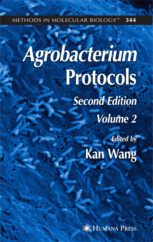Agrobacterium Protocols (2nd Ed., Softcover reprint of hardcover 2nd ed. 2007) Volume II Methods in Molecular Biology Series, Vol. 344
Langue : Anglais
Coordonnateur : Wang Kan

Agrobacterium tumefaciens is a soil bacterium that for more than a century has been known as a pathogen causing the plant crown gall disease. Unlike many other pathogens, Agrobacterium has the ability to deliver DNA to plant cells and permanently alter the plant genome. The discovery of this unique feature 30 years ago has provided plant scientists with a powerful tool to genetically transform plants for both basic research purposes and for agric- tural development. Compared to physical transformation methods such as particle bomba- ment or electroporation, Agrobacterium-mediated DNA delivery has a number of advantages. One of the features is its propensity to generate single or a low copy number of integrated transgenes with defined ends. Integration of a single transgene copy into the plant genome is less likely to trigger ?gene silencing? often associated with multiple gene insertions. When the first edition of Agrobacterium Protocols was published in 1995, only a handful of plants could be routinely transformed using Agrobacterium. Ag- bacterium-mediated transformation is now commonly used to introduce DNA into many plant species, including monocotyledon crop species that were previously considered non-hosts for Agrobacterium. Most remarkable are recent devel- ments indicating that Agrobacterium can also be used to deliver DNA to non-plant species including bacteria, fungi, and even mammalian cells.
Root Plants.- Carrot (Daucus carota L.).- Cassava (Manihot esculenta Crantz).- Potato (Solanum tuberosum L.).- Sweet Potato [Ipomoea batatas (L.) Lam.].- Turf Grasses.- Bermudagrass (Cynodon spp.).- Perennial Ryegrass (Lolium perenne L.).- Switchgrass (Panicum virgatum L.).- Tall Fescue (Festuca arundinacea Schreb.).- Turf Grasses.- Woody Species.- American Elm (Ulmus americana).- Cork Oak Trees (Quercus suber L.).- Eucalyptus.- Pine (Pinus radiata).- Poplar (Populus spp.).- Rubber Tree (Hevea brasiliensis Muell. Arg).- Tropic Plants.- Banana (Musa sp.).- Citrus.- Coffee (Coffea sp.).- Papaya (Carica papaya L.).- Pineapple [Ananas comosus (L.) Merr.].- Sugarcane (Saccharum spp.).- Nuts and Fruits.- American Chestnut [Castanea dentata (Marsh.) Borkh.].- Apple (Malus × domestica).- Blueberry (Vaccinium corymbosum L.).- Grapevine (Vitis vinifera L.).- Strawberry (Fragaria × ananassa).- Walnut (Juglans).- Ornamental Plants.- Carnation (Dianthus caryophylus L.).- Chrysanthemum (Dendranthema × grandiflora).- Orchids (Cymbidium spp., Oncidium, and Phalaenopsis).- Petunia (Petunia hybrida).- Rose (Rosa hybrida L.).- Medicinal Plants.- Ginseng (Panax ginseng).- Hemp (Cannabis sativa L.).- Opium Poppy (Papaver somniferum).- Non-Plants.- Actinomycetes (Streptomyces lividans).- Filamentous Fungi (Magnaporthe grisea and Fusarium oxysporum).- Green Alga (Chlamydomonas reinhardtii).- Mammalian Cells.- Mushroom (Agaricus bisporus).- Yeast (Saccharomyces cerevisiae).
Includes supplementary material: sn.pub/extras
Date de parution : 12-2010
Ouvrage de 512 p.
15.2x22.9 cm
Date de parution : 09-2006
Ouvrage de 512 p.
15.5x23.5 cm
Thème d’Agrobacterium Protocols :
Mots-clés :
DNA; Flora; algae; arabidopsis thaliana; fungi; genetic engineering; molecular biology; saccharomyces cerevisiae
© 2024 LAVOISIER S.A.S.



